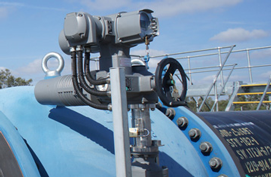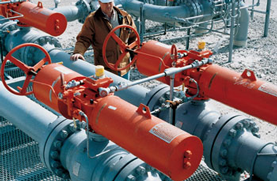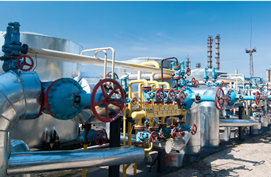
What is an Actuator? An actuator is the operator mechanism for opening and closing a valve remotely. It is mounted on top of the valve and coupled to the valve stem. Manually operated valves have a handwheel mounted on the stem and in some cases come along with a gearbox mechanism and requires someone in the field to physically operate them. Power-operated actuators can be operated using air pressure, hydraulic pressure or electricity and allow a valve to be opened or closed remotely. They also allow rapid operation in case of large valves. Power-operated valve actuators may be the final elements of an automatic control loop which automatically regulates some flow, level or other process applications. Actuators may allow intermediate positioning in addition to opening and closing the valve. Power operated valve actuators include control and instrument accessories mounted on them viz; limit switches, i to p converter and indicator to remotely indicate the open/close position of the valve.
Pneumatic Actuators: Air pressure or plant air is the power source for most pneumatic valve actuators. There are two types of pneumatic actuators, the diaphragm type and the piston cylinder type actuator. They are used on linear or quarter-turn valves. Air pressure acts on a piston or bellows diaphragm creating linear force on a valve stem. Alternatively a quarter-turn vane-type actuator produces torque to provide rotary motion to operate a quarter-turn valve. While majority of the applications prefer pneumatic actuators due to their light weight and rugged structure. Moreover they are cost effective and highly reliable. Pneumatic actuators are used in a potentially explosive environment as well. Also the failsafe action of pneumatic actuators is system inherent. A pneumatic actuator may be designed to be spring-closed or spring-opened, with air pressure overcoming the spring to provide movement. A double acting actuator uses air applied to different inlets to move the valve in the open or close direction. A central compressed air system can provide the clean, dry, compressed air needed for pneumatic actuators.
Electric Actuators: The Electric actuator uses an electric motor to provide torque to operate a valve. They are quiet, non-toxic and energy efficient. However, electricity must be available, which is not always the case. Electric actuators are mainly used in applications where compressed air is not available viz; in small systems for building automation or in some areas of power plants.The newer generation of quarter-turn actuators incorporates many of the features found in most sophisticated multi-turn actuators. They are compact, so can be used on smaller valves, and because of their lower power requirements, they can be fitted with an emergency power source such as a battery to provide failsafe operation.
Hydraulic Actuators: Hydraulic actuators convert fluid pressure into motion. Similar to pneumatic actuators, they are used on both linear or quarter-turn valves. Fluid pressure acting on a piston provides linear thrust for gate or globe valves. A quarter-turn actuator produces torque to provide rotary motion to operate a quarter-turn valve. Most types of hydraulic actuators can be supplied with fail-safe feature to close or open a valve under emergency shutdown circumstances. Hydraulic pressure can be supplied by a self-contained hydraulic pressure pump. In some applications, such as water pumping stations, the process fluid can provide hydraulic pressure, although the actuators must use materials compatible with the fluid. Finally hydraulic actuators are used in applications where the required force to operate the valve cannot be accomodated by pneumatic or electric actuators.

 Hot new
Hot new Hot new
Hot new Hot new
Hot new